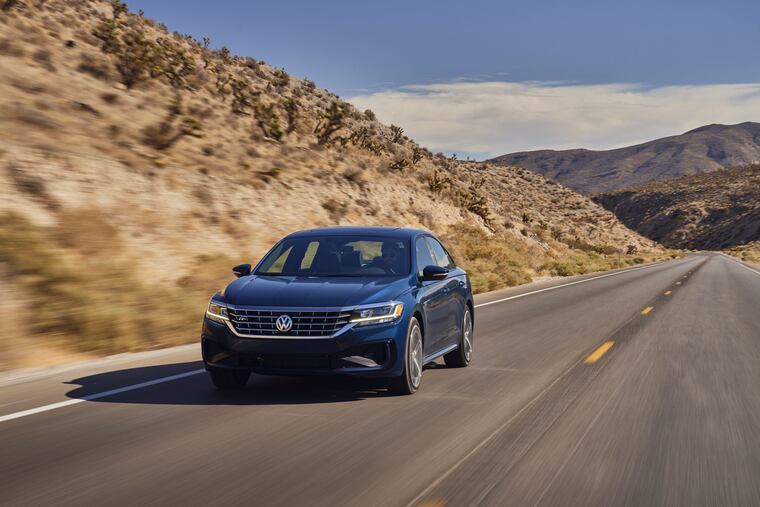Despite updates, 2021 VW sedan holds on to its inherent Passat-ery
The Volkswagen Passat is pitted against the Mazda6 and the Kia K5. The Passat offers a classic take on the category, with its German roots shining through. But is that enough to compete in 2021?

2021 Volkswagen Passat 2.0T SE: Classic German sedan?
Price: $27,990 as tested (no options on test vehicle)
Conventional wisdom: Car and Driver likes the “German-engineered sedan at a low price, lots of back-seat space, comfortable ride,” but not the “staid exterior styling, unimaginative interior, uninspiring acceleration.”
Marketer’s pitch: “Classic, comfortable and fun to drive.”
Reality: Some say classic, others say passé. Potayto, potahto.
What’s new: The sedan loses the 1.8-liter base engine and gets a bit more torque in the long-offered 2.0-liter turbo. That’s as of 2020; the Passat pretty much carries over unchanged into 2021.
The suddenly cheapish SE is actually a step down from the R-Line, a switch from previous versions. It’s not often that I get to test a lesser model — manufacturers usually want to show off their best. Keep in mind that this model costs far less than the Kia K5 tested two weeks ago or the Mazda6 tested last week, but it’s still a fair comparison.
Settling in: I’d long been a fan of the Passat. Though I only reviewed a 2012, I’ve been at events where I’d driven examples and ridden in others.
Now, sitting inside again, I looked around me and thought, “This feels like going back in time.” So much glass, such a low belt line, and the seating position felt like a car from 10 years ago. Not necessarily a bad thing.
» READ MORE: https://www.inquirer.com/cars/car-review-mazda6-keeps-on-keeping-on-20210326.html
Up to speed: The turbocharged 2.0-liter four-cylinder creates 174 horsepower. Pickup was all you’d expect for 174 horses, which these days is not that much. 0-60 takes 7.8 seconds, according to Motor Trend.
Shifty: The six-speed transmission works fine in automatic and shift mode, and shift feel is crisp and well-defined.
But I’ll never understand why Volkswagen offers a shift lever with Drive, Sport and Shift, and why Shift mode does not automatically engage Sport mode. If there’s anyone who wants to shift gears, it’s someone who enjoys a sporty-feeling car with tight handling and quicker pickup.
On the road: The above shift choices are not such a problem in the hot-rod GTI or in a sporty Jetta. But in today’s Passat it becomes a frustrating conundrum.
The front-wheel-drive Passat’s handling in regular Drive mode or Shift mode is OK. It’s very 1980s Buick Skylark, with front wheels that pull hard during acceleration or cornering, and steering that’s precise enough but has bunches of play. While sitting at a stoplight, Mr. Driver’s Seat could move the steering wheel almost an eighth of turn left or right before the steering would engage.
Sport mode improves one’s handling lot immensely, but restless, (over)involved drivers lose the shift option.
Driver’s Seat: Also, I remember the Passat being a whole lot nicer inside. This version was OK, but looked and felt cheap. The black leatherette front seats were firm, and the material seemed very old-school Beetle-y.
Perhaps try to upgrade the trim level. I checked out Sturgis Neighbor Guy 1.0′s 2016 R-Line Passat and found the seats to be much more comfortable right from the start. But the R-Line used to cost less than the SE so I think Volkswagen wants less to be more.
(Soon after, Neighbor Guy traded his Passat for an Atlas. Obviously my tough questions left him reevaluating his life choices.)
» READ MORE: New Kia K5 kicks off a round of affordable sedan tests
Friends and stuff: The rear seat remains a delight in the corner spots. The Passat offers plenty of legroom, headroom and foot room, even room to stretch out and up. The seat is comfortable enough. Middle-seat passengers will have to suffer on a large floor hump, though.
Cargo space is 15.9 cubic feet.
Play some tunes: Thankfully, Volkswagen sticks with its easy, functional infotainment system. Knobs for volume and tuning, buttons on the screen corners for source and sound adjustment, and a fairly simple touchscreen from everything else. The touchscreen is a bit small, especially in that the buttons are part of it.
Sound from the Fender stereo system was a little disappointing, about a B+.
Keeping warm and cool: The heater controls also remain a simple proposition. Dials control fan speed and temperature, while clearly marked buttons change the air sourcing and the seat temperature adjustments.
Fuel economy: I averaged about 23 mpg but hardly put 50 miles on this unit, thanks to the largest snowstorm in five years. Feed the Passat whatever.
Where it’s built: Chattanooga, Tenn.
How it’s built: Consumer Reports predicts the reliability to be 3 out of 5.
In the end: I never thought I’d be telling readers “Check out the Camry, shake hands with the Accord, listen to the Sonata, move the Kia K5 to the fore” in a Passat review. Or in response to last week’s Mazda6 review.
It may not be a completely fair comparison, as there’s a lot of room to add options. But the Passat engine and cockpit will remain basically the same, no matter the trim level, and neither the Passat nor the Mazda6 have all-wheel drive available.
Fortunately, the K5 has plenty of other positives to recommend it.